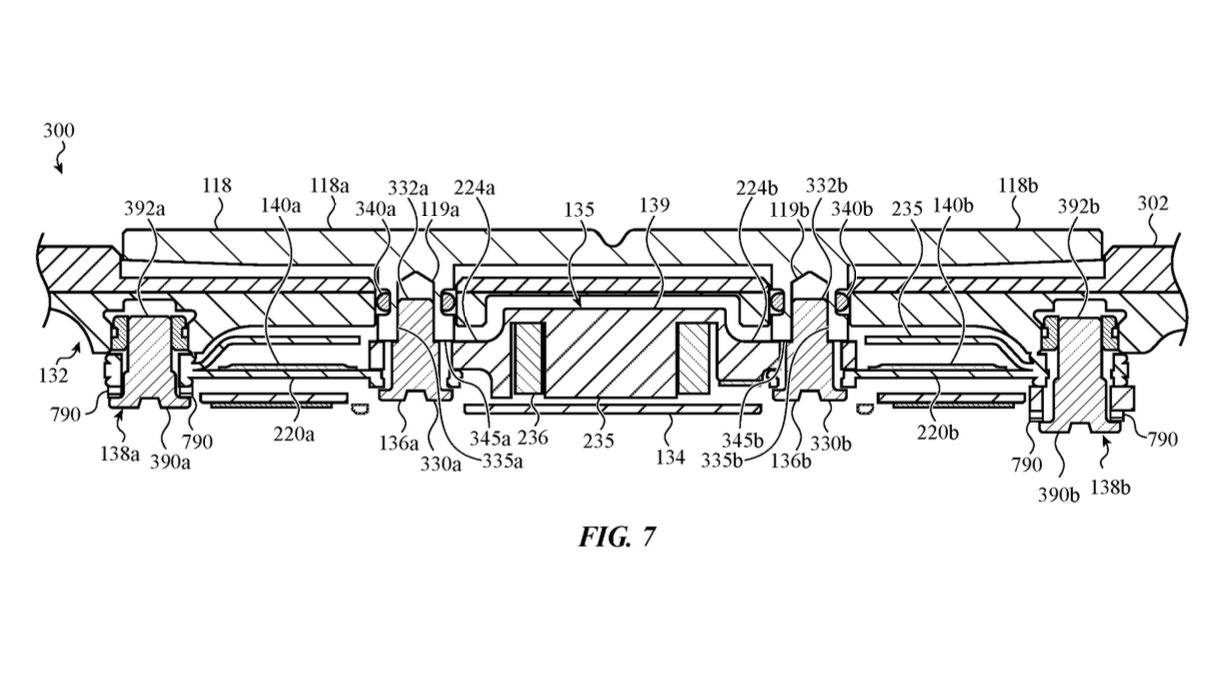news@appleinsider.com (Marko Zivkovic)
2025-04-18 18:08:00
appleinsider.com
Apple’s long-rumored haptic button design surfaced in a patent application. Image Credit: Apple / USPTO
We could see haptic buttons on a future iPhone after all, as Apple’s previously abandoned Bongo project has surfaced in a recent patent application.
In 2022, Apple came up with the idea of adding haptic volume and power buttons to more expensive iPhone models. Relative to the standard buttons used on the iPhone 14 range, the new haptic buttons would have incorporated a dedicated haptic engine for vibration feedback.
The change was also meant to facilitate a visual distinction between Apple’s base model iPhones and the more expensive “Pro” lineup. In April 2023, the hardware was abruptly removed from the iPhone 15 Pro, and it was believed that all work on the Bongo design had ceased. Surprisingly, however, it turns out that Apple had filed a patent application for its haptic button design.
Though it was filed in September 2023, Apple’s patent application was only made public in April 2025, making it the first time Apple has acknowledged the Bongo design in any shape or form. The patent filing includes depictions and descriptions of the haptic button design, but otherwise contains no previously unknown information.
Project Bongo, as it was known within Apple, made it relatively far into development, with fully functional prototypes being built. Even so, the Bongo design hasn’t been used on mass production versions of any iPhone so far.
AppleInsider was the first to show Apple’s haptic buttons on real-world hardware, in the form of an EVT-stage prototype iPhone 15 Pro Max. This was the last version of the iPhone 15 Pro that featured Project Bongo, as it was abruptly removed from CRB and DVT-stage unit designs in April 2023.
Apple also tested the design on pre-production prototypes of the iPhone 16 range. Later, the Bongo design was spotted on a drop-test prototype of the iPhone 14 Pro, which featured a rough, non-functional version of Apple’s haptic buttons.
How Apple’s haptic button design works
Even before Apple’s patent was made public, the details of the Bongo module design were already known. In our report detailing the EVT-stage prototype, we explained that Apple’s haptic button used flexures and strain gauges to detect changes in pressure. In short, once a press was detected, an electrical signal would be sent to the “Bongo Haptic Engine.”

Apple’s patent application outlines a button with an integrated haptic engine. Image Credit: Apple / USPTO
The Bongo Haptic Engine was an electromagnetic reluctance motor, consisting of a ferromagnetic core and copper coil, that together constitute a solenoid. It generated haptic feedback the same way the regular Taptic Engine does, by oscillating in relation to an attraction plate located underneath.
Apple’s patent application effectively describes the Bongo Haptic Engine:
The haptic engine may include a core and an electric coil disposed around at least a portion of the core. The core may be formed from a ferromagnetic material, ferrimagnetic material, or other suitable material (e.g., iron, ferrite, steel, ferrous materials, a permanent magnet, iron alloys, etc.).
The patent application also explains how the entire process works, which mirrors what we outlined back in 2024:
When a user presses the button, the core may move slightly toward the attraction plate. One or more force sensors (e.g., one or more strain gauges) attached to the haptic module may be used to detect the user’s press. In response to a processor or other circuitry detecting the press, an electrical signal may be applied to the electric coil. In order to produce a haptic output at the button, the electric coil surrounding the core may be energized (e.g., by a circuit that applies a current or current waveform to the electric coil), which causes the core to be attracted to the attraction plate.
Apple’s hardware descriptions ultimately come as no surprise, given that we’ve seen fully functional prototypes of the same technology. What remains to be seen, however, is whether the Bongo design will be repurposed for a future iPhone, or maybe something else entirely.
Will future Apple products feature haptic volume and power buttons?
While Apple’s patent application ultimately provides no new information about its haptic button design, it does include an interesting tidbit. In part, it mentions that the Bongo design featured throughout the document might be used in “various electronic devices,” including smartphones, tablets, and more.
-xl.jpg)
Apple’s haptic button design was used on prototypes of the iPhone 15 Pro. Image Credit: AppleInsider
The patent application explains that it could also be used on wearables, wrist-worn devices, head-mounted devices, and “electronic pencils.” This means that the haptic button module might, in theory, one day appear on an Apple Watch, Apple Vision Pro, or Apple Pencil.
Though at face value it seems like a distant possibility, it does align with a rumor from April 2025. Leaker Instant Digital claimed that Apple was “still adjusting the tactile design of solid-state keys and their reliability after long-term use.” At the time, they also said that there was a “problem of false touch,” and that “the responsiveness cannot be perfectly guaranteed.”
Judging by the leaker’s claims and the information AppleInsider received about the Bongo project, Apple’s haptic buttons have long been marred by technical difficulties. We were told that the project was originally shelved because of unsatisfactory test results and high hardware failure rates, and that still seems to be the case.
Still, Apple went through the trouble of filing a patent application for its issue-prone haptic button module, and the company tested the design across three different iPhone generations. There’s a possibility the Bongo design will one day resurface in some shape or form, and the company’s patent application is a strong indication that it hasn’t been discarded in its entirety.

Keep track of your essentials with the Apple AirTag 4 Pack, the ultimate tracking solution for your belongings. With over 5,972 ratings and a stellar 4.7-star average, this product has quickly become a customer favorite. Over 10,000 units were purchased in the past month, solidifying its status as a highly rated Amazon Choice product.
For just $79.98, you can enjoy peace of mind knowing your items are always within reach. Order now for only $79.98 at Amazon!
Help Power Techcratic’s Future – Scan To Support
If Techcratic’s content and insights have helped you, consider giving back by supporting the platform with crypto. Every contribution makes a difference, whether it’s for high-quality content, server maintenance, or future updates. Techcratic is constantly evolving, and your support helps drive that progress.
As a solo operator who wears all the hats, creating content, managing the tech, and running the site, your support allows me to stay focused on delivering valuable resources. Your support keeps everything running smoothly and enables me to continue creating the content you love. I’m deeply grateful for your support, it truly means the world to me! Thank you!
|
BITCOIN
bc1qlszw7elx2qahjwvaryh0tkgg8y68enw30gpvge Scan the QR code with your crypto wallet app |
|
DOGECOIN
D64GwvvYQxFXYyan3oQCrmWfidf6T3JpBA Scan the QR code with your crypto wallet app |
|
ETHEREUM
0xe9BC980DF3d985730dA827996B43E4A62CCBAA7a Scan the QR code with your crypto wallet app |
Please read the Privacy and Security Disclaimer on how Techcratic handles your support.
Disclaimer: As an Amazon Associate, Techcratic may earn from qualifying purchases.

















































































![Werewolf Bitches from Outer Space [DVD]](https://techcratic.com/wp-content/uploads/2025/08/61upPkjjMfL._SL1000_-360x180.jpg)























